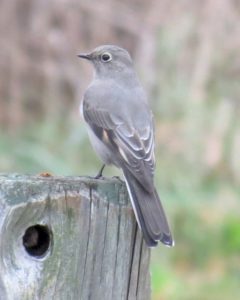Download the New IOS Field Checklist
The 5th Edition of the IOS Field Checklist of Illinois Birds is now available. Download the checklist now!
The 5th Edition of the IOS Field Checklist of Illinois Birds is now available. Download the checklist now!
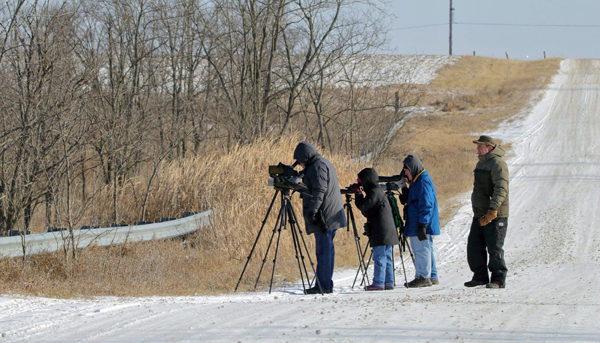
On January 7th, six hardened IOS members (Ted Wolff, David and Dale Kalina, Susan Zelek, Linda Foster and Tyler Funk) set out for a field trip this past weekend in search of Prairie Falcons and waterfowl. Leaving the house at 6:15am, my vehicle thermometer read -2° F. However, the sky was mostly clear and the air felt fresh as we set out to begin the day. Our first target was the Prairie Falcons. These birds have proven difficult to find this winter due to the extensive fall plowing that took place in the area. Finding a corn stubble field suitable for food and cover is not easy this season. Rough-legged Hawk, Merlin, Short-eared Owls and Northern Harrier are all relatively easy finds here most winters and they too are tough to locate this season. Another target in the area was a Snowy Owl which was found on January 6th about a mile east of what we call “Falconville”. We began driving a grid which allowed us to systematically check the area. This paid off with an early morning look at a Snowy Owl, but once again, the Prairie Falcon was a scratch. The group then made a sparrow walk through Larry Closson Habitat Area (aka Hickory Ridge) which yielded some nice sparrows for the day list.
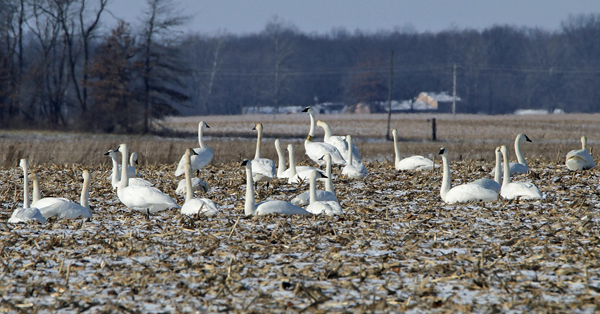
After a drive to Universal Mines, the thawed out group spent the next few hours attempting to estimate waterfowl numbers that blanketed the quarry. The waterfowl numbers here is always a highlight and the numbers of Trumpeter Swans is quite impressive. It certainly rivals any other spot in the state for sure. The group returned to the Prairie Falcon area, where we met up with Travis Mahan, Colin Dobson, Ron Bradley, Corey Lange and Tony Ward. The added eyes were welcome, but the Prairie Falcon remained absent. Those that remained to dark were rewarded with a nice sunset view of the Snowy Owl.
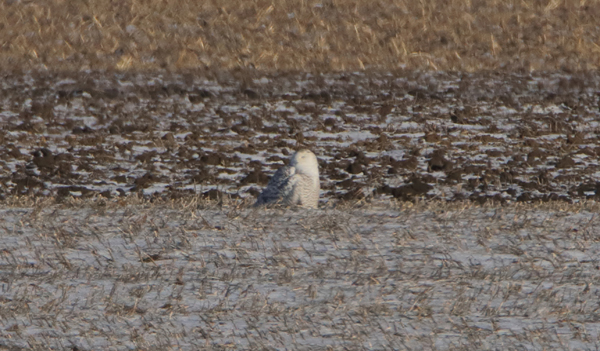
Thank you to all who attended. It was a fun outing!
Species totals:
5000 Greater White-fronted Goose
4000 Snow Goose
20 Cackling Goose
20670 Canada Goose
827 Trumpeter Swan
20 Gadwall
5 American Wigeon
2 American Black Duck
26 Mallard
1 Green-winged Teal
1 Canvasback
3 Redhead
35 Ring-necked Duck
5 Common Goldeneye
10 Hooded Merganser
1 Ruddy Duck
1 Ring-necked Pheasant
2 Northern Harrier
2 Bald Eagle
1 Red-shouldered Hawk
10 Red-tailed Hawk
2 Rough-legged Hawk
3 American Coot
2 Rock Pigeon (Feral Pigeon)
32 Mourning Dove
2 Great Horned Owl
1 Snowy Owl
1 Belted Kingfisher
1 Red-headed Woodpecker
1 Red-bellied Woodpecker
3 Downy Woodpecker
3 Northern Flicker (Yellow-shafted)
5 American Kestrel
16 Blue Jay
27 American Crow
134 Horned Lark
2 Carolina Chickadee
1 Tufted Titmouse
2 White-breasted Nuthatch
2 Carolina Wren
1 Northern Mockingbird
65 European Starling
31 Lapland Longspur
90 American Tree Sparrow
48 Dark-eyed Junco (Slate-colored)
3 Savannah Sparrow
10 Song Sparrow
4 Swamp Sparrow
9 Northern Cardinal
1 Eastern Meadowlark
1 American Goldfinch
74 House Sparrow
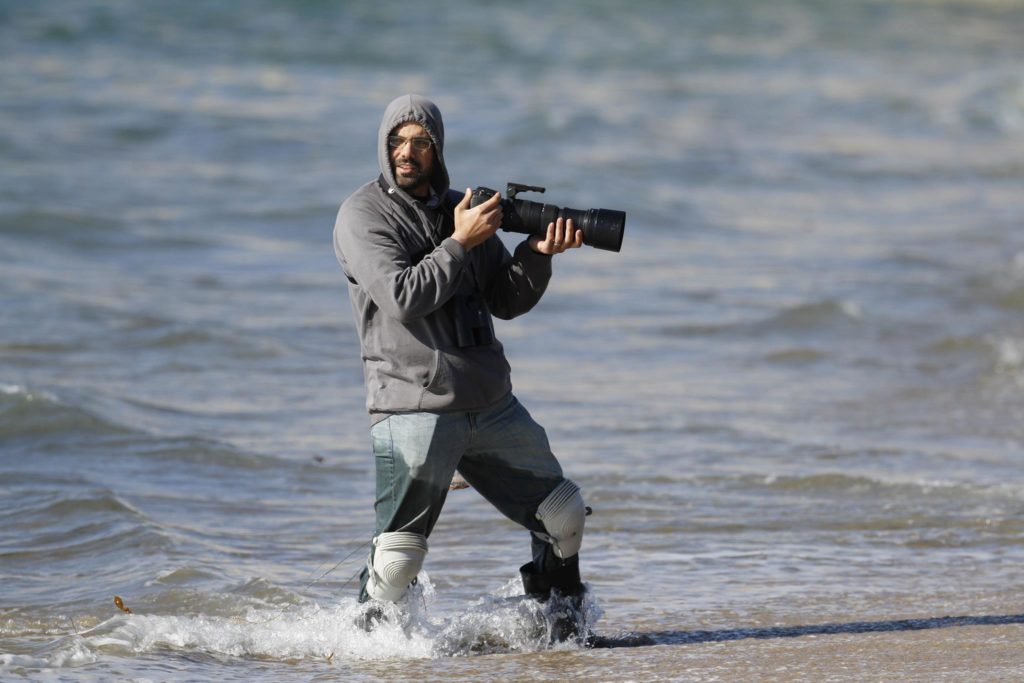
In advance of the IOS Gull Frolic, Amar Ayyash gives some advice to those just starting to get bit by the gull watching bug. Read Amar’s tips on his blog, Anything Larus.
Harlequin Duck: Will (North) – On January 1st, Doug Stotz reports an adult male Harlequin Duck on the DuPage River in Channahon.
Mew Gull: Will (North) – Doug Stotz reports a first cycle Mew Gull at Rock Run Rookery.
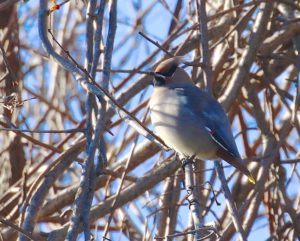
Bohemian Waxwing: Lake (North) – Eric Lundquist reports a Bohemian Waxwing at Shaw Woods in Lake Forest, Lake County.
Shaw Woods is part of the Lake Forest Open Lands Association. The property is just south of Oriole Grove Forest Preserve and can be accessed off W. Laurel Ave. The approximate location is marked with an X on the map.
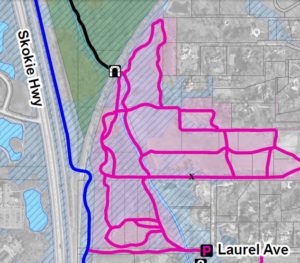
Prairie Falcon: Wayne (South) – For the second winter in a row, Bob Shelby has located a wintering Prarie Falcon in the Mt. Erie, Wayne County. One or two falcons have been seen as late as December 28, 2016.
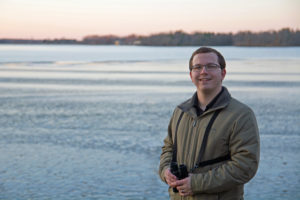
Shanin Abreu interviews Joe Phipps, who set a new McLean County Big Year Record in 2016 with 244 species.
Shanin: Tell us a little about yourself, Joe.
Joe: I am originally from East Peoria, IL, and I currently live in Bloomington with my incredibly supportive wife, Sam. I work for Vallen as a Storeroom Manager at a DuPont site. My interests outside of birding include photography, hiking, insects and spiders, and reptiles.
Shanin: When and why did you first become interested in birding and what has kept you interested?
Joe: I’ve always had a love for animals and nature as far back as I can remember, but I didn’t develop my fascination with birds and birding until I was a freshman at Illinois Wesleyan University. At IWU, I made friends who were also nature enthusiasts, and we took our first birding trip after reading an article about the large flocks of American White Pelicans at Lake Springfield. We borrowed binoculars and a field guide from the school, and things have never been the same since then.
Shanin: What has been your favorite birding moment or your favorite bird? Not necessarily rare, just meaningful…
Joe: This year has been filled with amazing birds and incredible experiences. One of my favorite birds to see this year was the Le Conte’s Sparrow. Not only was this bird a lifer for me, but it was very close and cooperative and I saw it with several of my favorite birders. It was definitely not an Ammodramus encounter that most birders get to experience.
Shanin: What is your favorite field guide? Favorite binoculars?
Joe: The Sibley Guide has been my go-to field guide from my first birding trip until today. Like many new-age birders, my Sibley guide is used as a reference in the field, but I most often find myself looking for the answers to tough IDs on list serves, blogs, and in birding groups.
I can’t say that I have a favorite pair of binoculars. I have had the Eagle Optics Rangers since I upgraded from my parent’s old Bushnells in 2011, and they have suited me in my endeavors. Like most birders, I dream of one day having a pair of Zeiss or Swarovski binoculars, but until then I will be content with whatever lets me see the birds.
Shanin: Where is your favorite place to bird in Illinois? In McLean Co?
Joe: Emiquon is easily my favorite place to bird in the state of Illinois. I love ducks, waders, and shorebirds, and Emiquon provides all of that and more. A good number of my life birds have come from Emiquon.
It’s harder to pick a favorite place in McLean County. For a long time I would have told you that Ewing Park was my favorite place because it offers so much with so little effort, but after this big year both Evergreen Lake and Schroeder Nature Sanctuary have become two of my favorite places to be. Both offer a diverse range of habitats, and are nice to be in even without the birds.
Shanin: Do you have anyone in the birding or environmental community that you consider to be your mentor? Why?
Joe: I have a couple of mentors that have played major roles in my development as a naturalist and a birder. When I was at Illinois Wesleyan, Dr. Given Harper took me out on some of my first birding trips. He taught me that birding is more than just seeing birds. It’s also about appreciating, understanding, and protecting them.
Benjamin Murphy has been my biggest mentor and motivator through my birding career as a county and state lister. We have spent countless hours together chasing rarities, checking local hot spots, and working on our buddy list. Ben has taught me most of what I know about the county, and without him I wouldn’t have been successful this year.
Shanin: What bird have you not seen this year that you feel you really should have seen?
Joe: I spent many hours driving around the county looking for Short-eared Owl and Northern Shrike both last winter and this one. There is still some time to look, but those two birds have taken so much of my time that I thought I would have one by now.
Shanin: What were some unexpected hurdles of your county big year?
Joe: Getting married in the middle of my big year was no small hurdle. I could no longer be gone all day, every day, with no consequences. It also came as a shock to me when I reached the point where birding stopped being fun and became a chore. It took some time to find a balance between birding because I enjoy it, and birding because I might add another species.
Shanin: What advice do you have for a birder attempting a county big year?
Joe: I would recommend that anyone interested in taking on a big year make sure that they have plenty of time to spend birding, a good understanding of what they need to be looking for and when, and a network of birders they can rely on. I think having any one of these things will lead to a productive year, but I wouldn’t have made it this far without all three.
Shanin: Do you have a favorite bird/birding quote or saying?
Joe: I have spent far too long thinking about an answer to this question, but if I had to quote any bird: “Who cooks for you? Who cooks for you all?” – Barred Owl
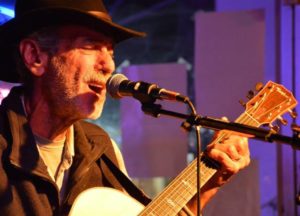
Riley and I left Chicago a little after 4 AM Monday, Dec. 12th and arrived at the Victoria grasslands shortly after sunrise. A hectic magical big-city weekend filled with parties, shopping, good food, languorous fires, Christmas lights… and SNOW! Ellen Baum and I had both planned to travel out Sunday afternoon. She stuck to her plan and headed for Pennsylvania. Made it but not without some white-knuckle driving near the end – her story to tell. I opted for a decent Blackhawks game, reheated Thai, a dying last fire, and a start in the dark. That worked, too.
Monday was the second day of the Knox Co. CBC (Christmas Bird Count) week. The count day was to be Wednesday, but a list is kept for the three preceding and three following days. I was particularly eager to bird my area after a six month hiatus from this hobby. The first stop rekindled my enthusiasm. A partly open pond east of Victoria held a big flock of geese of four species. Among the ducks were two ruddies and a ring-neck. Three ring-billed gulls flew over, a harrier made a pass, and a kingfisher rounded out the bounty. My enthusiasm, on hold since May, returned full-force.
I spent all day combing my territory: north of Victoria, then south down County 15 past Little John, and back to Oak Run where I often live. Highlights included three more kingfishers, two great blue herons, a lone robin, three Cooper’s hawks, two eagles, two fox sparrows, and a pileated woodpecker in my yard.
Spoon Lake added new ducks: one common and two hooded mergansers, five shovelers, three buffleheads, and seven common goldeneyes. I dropped Riley at the ranch and headed for Rask’s wetland west of Victoria. There is a dammed pond here set way back from the road, surrounded by cattails and nice grassland. A modest creek bleeds off it and comes west to the road, disappearing under it. I parked on the left shoulder so I could look without getting out of the car. In spite of the cold, this creek was open, terminating in a verdant pool spattered with bright green duckweed. I began taping for a swamp sparrow. Something splashed just inside the cattail edge. I stared. Nothing. My attention returned to the sparrow quest. Then something moved, giving me the briefest tease. It had some size to it. I immediately thought, “Rail”, and played a Virginia rail call. Out stepped a SORA! It stood in full view at thirty feet for several seconds.
Soras are fairly common in season. Don a pair of Wellies and walk wetlands, and you will find them. But not in winter. Jim Mountjoy did a quick search of Bohlen’s “Birds of Illinois” and eBird and found only one record, from a CBC in Rantoul in 1912! He came out to look for the bird but failed. But failed is a relative term, because as he taped, a marsh wren flew in responding to marsh wren background noise on his sora recording! He called me and I joined him quickly to enjoy this second wonder. Alas, neither of these birds was relocated, but they certainly brightened our all-time Knox CBC week list (begun in 2002) bringing our total to 122 species.
Jim and I parted and my afternoon continued. Thinking about conditions, one thing I noticed throughout the day was frozen green grass. November was so mild to the last. Friends and I had golfed at the end of the month in short sleeves on a 75 degree day. Then December came in like a lion and flash-froze all the lush greenery.
Late afternoon as I sat scanning open fields, trying to turn blowing leaves into longspur flocks, I saw three deer heading across the road in full flight. A doe led the way, followed by a young buck and a barrel-chested twelve-pointer. As he sprinted across the plowed field, with each hoof strike he atomized dirt clods like Hostess Sno Balls with firecracker centers.
The sun dipped stage left prompted by a near-full moon stage right. Coyotes too eager to wait for darkness loosed their primordial caroling from three compass points. I, in most of the clothes I own, scanned a prairie plot for short-eared owls. After twenty minutes my shivering reached the point where my binoculars were striking me in the forehead. The faintest of breezes whispered in my ear, “I could kill you if I wanted to.” Alas, the owls refused to witness this.
I returned to Victoria early Tuesday morning for another go at the owls. I missed them last year. They are most active at dawn and dusk, so the window is brief. Forty-five minutes later the sun wished me good morning, and my window slid owllessly shut. So it goes.

I rechecked ponds and could see that I was witnessing ice-up. Open water was disappearing quickly. My most productive pond from yesterday was reduced to a small pool packed with geese. Most of the ducks were gone. But then four trumpeter swans, elegant and ghostly in the early morning light, passed right over me.
I returned to the sora/marsh wren site but had no fortune other than a late muskrat. I continued south on 2400N and made a left on 1400E. I drove 1/10th of a mile and and spotted a bird T’d up on the top of a scrawny little tree and knew I had a prize. My glasses soon confirmed a northern shrike. This unique songbird/predator has proven to be quite regular in the county in winter, but is always a joy to find. Turns out it was a first of the year for me and worthy of another call to Jim, who came out and refound it, a first of the year for him as well.
I did a cursory audit of Spoon Lake and returned home by 9:30. I was tired, it was cold, and I had chores. I opted for an easy day and fully charged batteries for the count. I kept an eye on my deck, noting that “my” purple finches and one lone white-throated sparrow were coming in, as well as a tardy chipmunk. To my delight, late in the afternoon a Carolina wren visited for the first time in many days.
Wednesday, 3:30 AM, I arose and made much coffee. My deck snapped, crackled, and popped when I stepped out to check the weather. A full moon posed high in the sky, my wind chimes hung in silence, but the cold was profound. I put out an extra ration of bird seed and walked the BBD, listening for owls. I smiled as I recognized the return of my child-like enthusiasm. Contigo moving mug, journal, clipboard, pen, check-list, Jim’s CBC tally form, food, binoculars, spotting scope – check. Five AM, let the count begin!
I circled Spoon Lake, stopping and listening, Soon enough, barred and great horned owls broke the perfect silence. I will never tire of this. I finished my lake circuit and headed north to the grasslands a little before six. The sky was just paling on the east horizon. Time for yet another go at short-ears. I never stop hoping. This morning I tried the Rask/Fredrick wetlands first. The habitat is great, the results not so much. I only had time for one more site, so I floored it for 1700E between 2300N and Highway 167, ten minutes away. I cruised slowly along the one mile stretch, windows down, heat on max. Nothing, nothing, nothing, BIRD! I popped out of the car and brought this floppy moth-like wraith into focus. Success at 6:30 straight up. Ah, the rush of a good bird, hard-sought!
I cruised the rest of Coal Road as the firmament worked through a palette of obsidian, cobalt, a smear of turquoise, and then a blush of peach. A thin buffy yellow heralded the return of the sun for what it was worth. Light yes, and useful. Heat not so much. Harriers began turning up. It would be a good day for them, in fact unprecedented on the count. Our circle wound up tallying 32. I feel certain that many of them had just arrived from up north.
I returned to 2400N shortly after sunrise and immediately relocated the shrike. This can be devilishly hard because they hunt territories of many square miles. Ever the optimist I returned to the sora spot. I walked in some distance on both sides of the creek but could see that even this magic water was losing the battle to the cold. After twenty minutes of trying not to fall over or break through the ice I returned, birdless, to the car. So it goes… and sometimes doesn’t.
I moved on east and was not surprised to see all of the ponds iced up. I hoped that the strip mine pond off 2250N just west of 180 would still have an open pool. It did but was shrinking quickly. The geese were now shoulder to shoulder. No snow geese. They would elude all of us this day. And the duck list didn’t take long: mallard, gadwall.
I worked south on County 15 headed back toward Oak Run. A half mile north of the Fremont T by Little John I braked for a big flock of roadside birds. Usually these are juncos and American tree sparrows with the occasional goody. But in this bunch there were fifteen white-crowned sparrows and a fox sparrow – nice! Then a small but menacing raptor flashed in. The flock panicked off, and the would-be killer perched, giving me a great look at the day’s only sharp-shin.
On my way again, I found a lone red-winged blackbird near a feeder by the Sherwood Youth Camp. Later at dusk as I sped to the dam for a last look at waterfowl, I encountered a phenomenon that has happened in other recent years. Hundreds of blackbirds were streaming northwest between the dam and Brentwood Park on their way to roost. I managed to ID eighteen grackles before the light failed. I wrote down a frustrating 1600 icterid species. I never did have a cowbird on the day.
The youth camp has almost always contributed good birds on the count, but not this day. It was time for my first look at Spoon Lake. Starting at Windemere Park I could see significant increase in freeze. Waterfowl variety here was not good. I drove Oak Run Drive to the beaver pond. This is my go-to spot for great blue heron even in years when the lake is 100% ice. It is also a painless acquisition. I parked next to the guard rail, rolled down my window, and there it was, standing knock-kneed in a pretty pool.
I continued around the lake to Knollcrest Circle. The thing about Oak Run is, there are a couple of places where one can easily scan the lake, but there are many stretches where one must peer through trees and between houses. Ducks will be scattered all over the lake, and this is how to find them. Knollcrest produced the count’s only green-winged teal, wigeon, and lesser scaup. The dam was next and here the lake was wide open. A slow careful scoping yielded more treasures: common and hooded merganser, ruddy duck, common goldeneye, and two lovely drake redheads. As I sorted through geese up on a lawn I stumbled on two foraging bluebirds. Then a kingfisher rattled by. Good stuff!
I wheeled around to Brentwood and had a Cooper’s hawk zip by. I jumped out to look at it and heard a curious grunting overhead. Passing right over me were eleven trumpeter swans beating steadily and powerfully down to the lake.
There is a big stand of white pines off south Oak Run Drive. I walk through it every count. It has to be the biggest pine woods in the county and can contribute birds not to be found elsewhere. This count there were no birds. But there was something else. I have had this thought before but was glad to revisit it. A winter walk through a conifer grove needs no other reason than the doing of it. It is reverential. Add the sound of the wind and you rival the magic of the surf on any beach.
Lakeview boat launch was next up and contributed my day’s only bald eagle and buffleheads. At one PM it was time for lunch with Riley. I needed white-throated sparrow, purple finch, and Carolina wren, all of which have been in my yard for weeks. I gave the BBD a leg stretch, restocked seed, heated beef stew, and pulled up a chair to stare at my deck. The sparrow, a window-strike survivor, politely showed. I taped for the wren… crickets. I walked around the yard taping for the finches, daily visitors (I have ten of them as I write this). Aragorn voice-over, “But not this day!”
I reviewed my notes and tallied up fifty-four species as of two PM, a respectable total. I made note of my misses, reloaded the contigo, and headed back out. Over the next three hours I only added six species. Winter afternoons are tough. A revisit to the 2250N goose pond was worthy. I hopped the fence to see over the high edge, knowing a number of birds were out of sight from the road here. To my delight staring back up at me were a coot and a hen canvasback! My waterfowl list for the day finished at sixteen, and that without snow goose, shoveler, and ring-necked duck, all seen on Monday. A very nice total.
I spun around Spoon Lake one last time as dusk was coming on. This was when I had the flights of blackbirds. The grackles passing over brought my final total to sixty species for the day. Back at the ranch I let Riley out one more time, grabbed a bottle of wine, and headed for Galesburg. Jim and Jennifer graciously host a chili dinner/compilation every year, welcoming us to gather around a fire and put our count together. Jim’s chili is reason enough to do this count.
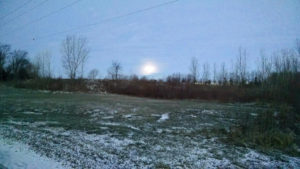
Forms were observed. Jim opened his laptop and started through the check-list, asking each party for their results one species at a time. Prior to this secrecy is maintained, so that everyone is hearing the results for the first time. At the end we put together seventy-three species, seven short of our record best, but a fine total on a challenging day. Later we learned Alice Larson had a pine siskin, lifting us to seventy-four. Eight other species went on the count week list and just now I’ve had a sapsucker in my yard, also new. Jim had the bird of the day, a saw-whet owl at Little John predawn, giving us five kinds of owls. We also had ten different diurnal raptors, another highlight. While there were certainly many other birds we could have found (again, our all-time count week list stands at 122), I felt we only had two regrettable misses: pheasant and Lapland longspur.
And now, Friday night, I am off to the Beanhive open mic and a party with dear friends. Thank you, Lord God for these days at play in your fields! I love my life! Merry Christmas!
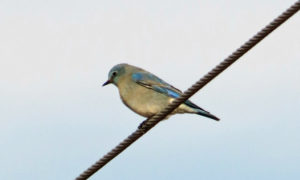
Mountain Bluebird: Carroll (North) – Young birder, Ethan Brown, and his mom, Cindy, photographed a Mountain Bluebird along Spring Lake Rd, by the Tri-Township Airport south of Savanna, IL in Carroll County on 9-Dec-2016.
Brant (unconfirmed): Henderson (North) – Reported from the Iowa Birding Mailing List. A seasoned duck hunter reported seeing a lone Brant in a flock of mixed geese near Lake Stevenson on Highway 34 in Henderson County on 5-Dec-2016.
|
|
One of IOS’s objectives is “To promote scientific research and education in order to improve knowledge and awareness of birds in Illinois”. The IOS Grants Program was initiated several years ago to support this objective with funding.
The 2016 IOS Grants Program received 13 requests for funding. The IOS review team evaluated each proposal, and determined that all were suitable for funding within the scope of that key objective described above. In addition to money provided directly by IOS, donations by five organizations and many individuals (see the alphabetical lists below) made it possible for all of the 2016 grant requests to be fully funded. Funding 13 Grants is a milestone – the largest investment in research on Illinois birds IOS has been able to provide, since the inception of the Grants program! |
|
|
|
|
Thanks to you all! Without the generosity of these organizations and IOS members and friends in the bird conservation community, IOS would not be able to support these projects. The support exemplified by this funding sends an important message to these students and researchers: We believe in your work, and we care about the future of our state’s birdlife! Thanks to Jeff Walk and Steve Bailey for reviewing and rating all the requests. Congratulations to the Grant recipients! Watch for their project articles in future issues of The Meadowlark and watch for short summaries on the IOS website. Here’s a synopsis of the 2016 Grants. Where noted, individuals and organizations targeted those Grants for their donations. |
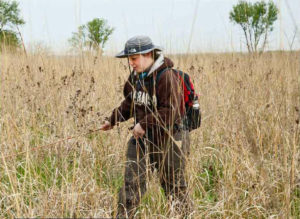 |
| # | Amount | Name/Organization | Description/Sponsor |
|---|---|---|---|
| 1. | $1,000 | Abigail Blake-Bradshaw U of I Urbana, Illinois Natural History Survey, and Forbes Biological Station |
Wetland quality for waterbirds in Illinois. Sponsored by DuPage Birding Club. |
| 2. | $1,000 | Olivia Choy Northeastern Illinois University |
Migration and parasite communities in avian hosts. Sponsored by IOS ($750) and COS ($250). |
| 3. | $1,000 | Brett Dorak U of I Urbana and Illinois Natural History Survey |
Ecology of wintering Canada Geese in the Chicago metro area. Sponsored by IOS ($500) and individual donors ($500). |
| 4. | $1,000 | Elizabeth Errickson U of I Springfield |
Winter movements and habitat use of Short-eared Owls in an agriculture-dominated landscape. Sponsored by individual donors. |
| 5. | $1,000 | Andrew Gilbert Western Illinois University |
Detection and disturbance rates of waterbirds during aerial surveys. Sponsored by IOS. |
| 6. | $1,000 | Jesse Hacker DePaul University |
Effects of urbanization on neophobic behavior and problem solving performance in American Crows. Sponsored by IOS ($750) and COS ($250). |
| 7. | $1,000 | Heather Herakovich Northern Illinois University |
The effects of bison reintroduction, prescribed fire, and time since restoration on grassland birds in tallgrass prairie. Sponsored by DuPage Birding Club. |
| 8. | $1,267 | Taylor Joray Illinois State University |
Summer origins of American Kestrels wintering in Illinois. Sponsored by Lake-Cook Audubon. |
| 9. | $1,000 | Jaime L. Lange U of I – Springfield |
Spatial and temporal interactions between Brown-headed Cowbirds and bison at Nachusa Grasslands. Sponsored by IOS ($850) and Lake County Audubon ($150). |
| 10. | $1,000 | Aderinsola Odetunde Illinois State University |
Effects of blood loss and mite infestation on nestling developmental trade-offs and parental provisioning. Sponsored by IOS. |
| 11. | $1,000 | Ben O’Neal and Heath Hagy Franklin College and Illinois Natural History Survey |
Breeding ecology of waterbirds at Emiquon Preserve. Sponsored by Lake-Cook Audubon. |
| 12. | $1,000 | Emilie A. Ospina U of I – Urbana |
The role of incubation behavior in shaping developmental physiology in a wild passerine. Sponsored by IOS ($500) and individual donors ($500). |
| 13. | $1,000 | Cassandra Wilcoxen U of I – Urbana |
Cover crops in an agricultural landscape: Beneficial to birds during spring migration? Sponsored by IOS. |
The Illinois Ornithological Records Committee (IORC) recently concluded evaluation of 26 records of occurrence of rare birds in Illinois, accepting 20 and not accepting six. For each record, we indicate the species or form, with number of individuals in parentheses if greater than one, followed by date or date range, location, and county. At the end, the record number is indicated in parentheses, followed by, for accepted records, names of the documenters. IORC thanks all the documenters, for accepted and unaccepted records alike, for their submissions. All documentation is maintained in the IORC archives so that there is a permanent record of all these observations. Documentation, regardless of the Committee’s decision, is a valuable part of the record of bird life in Illinois.
Records Accepted
Records Not Accepted
Rufous Hummingbird: Saline County (South) – On 27-Nov-2016, Cathy DeNeal has a hatch year female Rufous Hummingbird coming to her feeder in Harrisburg, Saline County.
Mottled Duck (unconfirmed): Mason County (Central) – On 25-Nov-2016, Mike Ingram reports a Mottled Duck in the extreme south corner of the upper pool at Chautauqua NWR near Eagle Bluff.
Townsend’s Solitaire: Winnebago (North) – On 25-Nov-2016, Ray Fini found a Townsend’s Solitaire at Rock Cut State Park near the first parking lot off IL-173 on the north side of the prairie.
